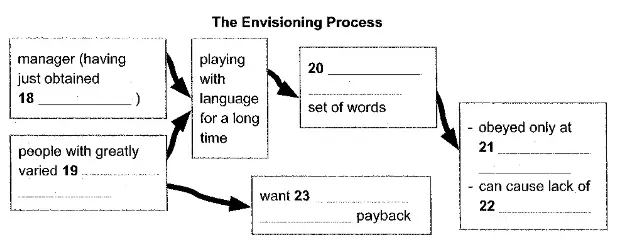In the past, management took a minor role in influencing motivation. It was generally considered that if the correct tools, training, and environment were provided, individuals would do their jobs, and that this was sufficient in itself. People in organisations were considered ‘personnel’. But look how it has now changed. ‘Personnel’ have become ‘human resources’. and staff are now seen in terms of strategic potential, and with appropriate development, are one of the most important assets organisations may have.
A key aspect of this is motivation, and to achieve it, the latest buzzword is envisioning. We often hear management gurus propounding the thesis that any leader of worth must have a vision. This can unite, inspire, and direct the energies of the staff in the right direction. In the absence of such a ‘visionary leader’, the organisation necessarily flounders in complete aimlessness – or at least, that is what we are led to believe. And yet I strongly disagree that this ‘vision thing’ (as famously referred to by former American President, George Bush Senior) is worth much at all. I’d even go further, stating that it can be distinctly bad for the organisation.
The first fact to realise is that ‘envisioning’ fails to acknowledge the true human nature of organisations. These places are not composed of lemmings., all with a simplistic and single-minded dedication towards one goal. They are most obviously composed of groups of human beings, and with their rich variety of personalities and experiences, no such community can be homogenous and share exactly the same sat of personal values. These people are, in fact, merely loosely-bound cohorts pursuing different objectives (status, money, power, or individually defined agendas), in different manners. Thus a truly shared and meaningful vision is very difficult, and often impossible, to generate.
Yet the ‘visionary’ manager attempts to do just this. The trouble is, the high-minded dictates of his fresh MBA do not mention becoming bogged down in a long, laboured excess of word-smithing, or how, in order to reach a consensus, the vision necessarily loses all individuality. The books do not mention the passionless and sterile written exhortation which is ultimately produced, of working towards ‘unshakeable integrity’. As admirable in content as these may be, they are merely corporate mantras rather than words to be lived by. Few will believe in something imposed from above, instead merely complying at a superficial level.
The unfortunate fact is, when turning from rhetoric to reality, the contradictions can be overwhelming. Deep down, all staff members know that envisioning is attempted not to create a more egalitarian company, but only as a means of enriching the company directors. But what about those staff member? Few of them work merely for the love of their job. In a materialistic and consumer-driven world, they work for hard and tangible rewards. This can take many forms, but certainly involves the company giving back profit in the form of salary, overtime, TOIL, bonuses, perks and extra days off. Personal visions never, ever, mention these.
Here’s another reason why envisioning is dubious at best. Workers do not like to be treated as products in the service of profits, or cogs in the organisational machine, yet envisioning ranks them as even worse – as animals in a sociological experiment. The assumption is that they lack their own personal vision and are helplessly adrift, deficits which can only be remedied by a great leader who can herd the lost sheep in the right direction. This is not a feeling likely to enhance commitment to the cause, and often make staff feel the very opposite, a fact about which I can personally testify from my own experiences of working in big companies where the envisioning farce was played out.
Personal visions are, in fact, necessarily complex. Almost everyone would surely have difficulties in articulating their deepest motivations, as well as in being honest about this to themselves. They would similarly have some reluctance to openly talk on the subject, often with people who might be competitors for that next promotion. Furthermore, envisioning begs the question of whether a vision is even necessary. Some people are not driven by a determination to stridently blaze a trail through life. This may merely show a spiritual calm, and a desire to appreciate the present. It may also be a smarter and more strategic approach to life’s unpredictable turns, applying equally well to the business world. In short, a lack of vision may be better – much better.
George Bush, as with many presidents, occasionally did not articulate his thoughts clearly, but his famously dismissive comment about envisioning speaks volumes. ‘That vision thing’ is remarkable in its concision. In just three words, it encapsulates the trendy, contrived, pigeon-holing, simplistic, top-down, and often insulting and hypocritical nature of the process. Mr Bush, you have my vote.
Questions 14-17
Answer the questions. Choose NO MORE THAN TWO WORDS from the passage for each answer
14. Broadly, what do staff need in order to most benefit a company?
15. Which people advise envisioning?
16. What do they believe a lack of vision might cause?
17. What aspect can groups of people never have in common?
Questions 18-23
Complete the flow chart. Choose NO MORE THAN THREE WORDS from the passage for each answer.

Questions 24-26
Choose the correct letter, A, B, C, or D.
24. Most people
A can define what makes them want to succeed.
B will discuss their personal visions with others.
C are interested in promotions.
D express their deeper feelings truthfully.
25. Personal visions
A take people forward in life.
B result in the absorption of immediate details.
C provide defence against unexpected events.
D help calm people’s minds.
26. With regard to envisioning, the author feels
A critical.
B contemptuous.
C impartial.
D suspicious.
